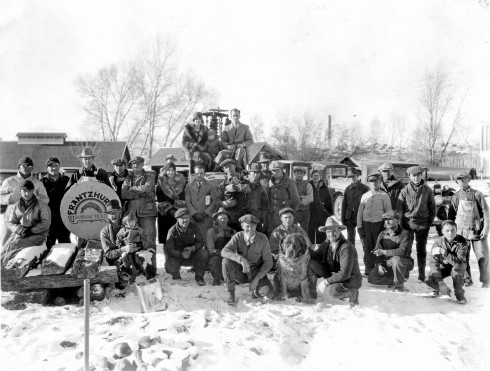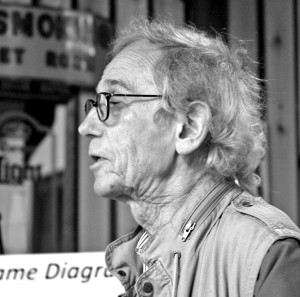by Susan Bavaria
But Tessie weeks later shared a similar fate
And wound up one night on a Senator’s plate;
With lemon and spices and other things good
Our Tessie from Frantzhurst had now become food.”
from A Tale of Tessie the Trout © Frantzhurst Trout Farm
In the 1930s, the Frantzhurst Rainbow Trout Company of Salida shipped their product fresh in wooden boxes covered with ice by truck and refrigerated railway car. Two million pounds of rainbow trout went annually to clubs, hotels and restaurants from coast to coast who found its “firm white flesh” as good as advertised. The company employed about 30 people and was second only to the Royal Gorge Bridge in attracting tourists to this area.

Back in 1919 Horace Frantz, Sr., former Naval Air Corps pilot in World War I, drove a Model T Ford from Chicago to Colorado Springs, where he started a poultry farm. In 1926, with young family in tow, he moved to Salida and built a log house that still stands on CR 154, a structure now owned by the Colorado Division of Wildlife (CDOW). His plan was to build a trout farm, and ultimately make it the “biggest attraction in this section of the state” according to the Salida Mail, May 30, 1928.
Frantz, Sr. acquired 1,000 acres, land north of CR 160 that included a gravel pit, the old Gun Club and property next to the former Chaffee County Poor Farm. (Horace Frantz, Jr. eventually built an airstrip here to land a small plane used to fly his father to additional hatcheries at Walsenburg and Colorado Springs.) Frantz, Sr. dug out fields on this land and acquired water rights for Harrington and Cemetery Gulch Ditches to fill Frantz Lake and other ponds that received the spillover.
“My father never used water from the river for the hatcheries and piped fresh spring water instead because he thought there would be too many chemicals from the Leadville mines.”
Frantz, Sr.’s marketing message was that fresh air made a better fresh fish, and he took pride in advertising how “water charged with fresh oxygen” cascaded down a concrete drainage spillway to the rearing runways and kept fish healthy. The company included a Sunshine Map of America in promotional material touting the “ideal all year climate of the Salida area of Colorado.” Mrs. Genevieve Frantz thought the suffix “hurst” added a bit of cachet to the company name which is how the name became Frantzhurst Rainbow Trout Farm.
Each year, the fastest growing trout were separated and placed in a special pond kept just for spawners. When spawning season began in January and February, they carefully stripped eggs and sperm from the fish, which were returned to the pond to be used again the following year. This operation was done inside a shed over the pond as sunlight killed the eggs.
In the 1940s, a three-page article in The Saturday Evening Post attracted attention to the family enterprise. Advertising agency J. Walter Thompson contacted Frantz, Sr. with a letter of inquiry whether or not his business used Ford trucks. Frantz Sr. responded that he had used Ford products for more than 22 years. He proceeded to outline in a letter how Ford trucks had gotten them through hub-deep mud and Texas rainstorms. It wasn’t long before J. Walter Thompson had a camera crew out at Frantz’s trout farm to film the Ford truck print magazine fall campaign.
Frantz, Jr. planned to attend either Washington State or Cornell University to study fish husbandry and landed at Cornell. When professors found out who his father was, they told Jr. that he should go back home since his father was the foremost authority on raising trout in the country.
“I did an exchange with the U.S. Fish and Wildlife Service,” says Frantz Jr. “I studied with them for a year for free and we exchanged our ideas with theirs.”
Starting in 1946, Frantz Jr. climbed Mt. Shavano to set off fireworks on the Fourth of July accompanied by college fraternity brothers from St. Louis and Navy buddies. The last year they attempted this feat there were 35 young people from 22 different cities and 14 states. Being a pilot, he dropped the fireworks on top of Mount Shavano from a plane a day earlier. The event was listed in United Press and Associated Press newspapers as the highest fireworks display in the United States.
After World War II, Denmark and Japan brought frozen fish to households across the United States and Frantz, Sr. decided to close operations rather than expand into the frozen fish market. On June 6, 1953, the Frantzhurst Rainbow Trout Company, once-reputed to be the largest trout farm in the world, went under the sheriff’s auction hammer for a bid of $130,000 to the Reconstruction Finance Corporation.
Producing fish today is a balancing act performed by the Mount Shavano Fish Hatchery, which provides the right mix of quality water, temperature and food to keep their fish in an optimal disease-free state. The hatchery, which sits next to the site of the Franzhurst raceways, raises rainbow trout, kokonee salmon and the endangered cutthroat greenbacks for recreational use.
“We have 200 different delivery sites,” says Matt Schehrer, Hatchery manager. Frantz Lake is one of the fish delivery spots for a few of the 350,000 catchables (10 inch fish) released annually. The hatchery water is sent to Sand Lake where solids sink to the bottom before surface water is discharged into the Arkansas River. Sub-catchables, which require a richer nutrient density to grow, find homes at Eleven Mile and Antero Reservoirs and Sand’s Lake.
The Hatchery obtains eggs from a brood unit in Carbondale. In one nondescript building that is not open to the public, young fish dart around with their same-aged peers in a series of concrete raceways. Some of the babies still have an egg casing attached to the body. Against the wall, behind several plastic shower curtains decorated with fish and strung together, 80,000 pink eggs with one black eye spot each bounce around lightly in a clear cylinder filled with water and pumped with air. Perhaps one of these, like Tessie the Frantzhurst trout, will end up on a senator’s plate too.
Mount Shavano Fish Hatchery offers daily, free, fish hatchery tours where people can see a video and feed the fish. Call for summer hours. 719-539-6877
Susan Bavaria finds a singular similarity between a cylinder of 80,000 fish eggs and the ancient evil slime in John Carpenter’s 1987 horror film Prince of Darkness.


My friend Robert Bruce just read a similar article by Mr. Frantz
in a 2005 copy of Reminisce magazine.
Mr. Bruce’s father established an earlier trout hatchery in 1918 in Salida and after the trgic death of his young wife gave up what at the time was a thriving enterprise.
The Hatchery is now owned by the Colorado Deptt of Wildlife.
Mr. Bruce would very much like to contact Mr. Frantz It
would appear from the picture that Mr. Frantz was about the
same age as Mr. Bruce was when his Dad had the Hatchery.
Could you help put them in touch
Maryann Pike